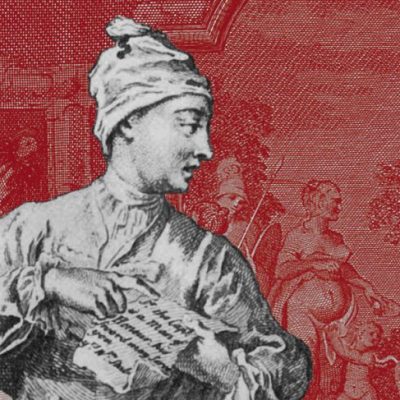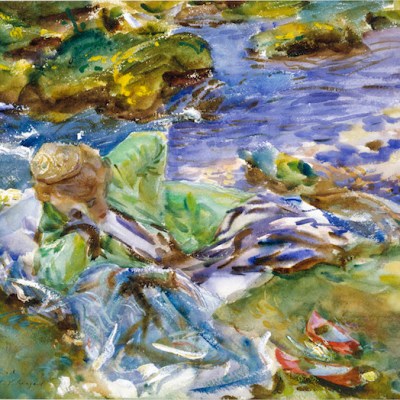Jewel-like, and embellished with engrossing details, the exquisite little panel at the centre of the National Gallery’s current exhibition is a rare evocation of Rimini at the turn of the 14th century, a city whose prodigious artistic output has been all but lost to earthquakes and war. Something of the city’s hustle and bustle is reflected in the influences discernible in this painting, from the Byzantine icons and ivory carvings that came in through the port, to the innovations of Giotto (1267 or 1276–1337), who was probably in Rimini just before 1300, carrying out commissions for the city’s Franciscan friars.
Established in the mid 13th century, the Mendicant orders sought to emulate Christ, renouncing property to serve as itinerant preachers, teaching and tending to the sick and poor in Europe’s developing urban centres. Despite their vow of poverty, they attracted considerable patronage, and the Franciscan and Dominican orders, as well as the Augustinian friars, used their wealth to fund some of the most ambitious artistic programmes of the late medieval period.
Scenes from the Lives of the Virgin and other Saints (1300–05), Giovanni da Rimini. © The National Gallery, London

Acquired in 2015 thanks to a donation by the American philanthropist Ronald S. Lauder, the National Gallery’s Scenes from the Lives of the Virgin and other Saints (1300–05) is joined by two other panels attributed to Giovanni da Rimini, between them constituting not only the sum total of extant panel paintings firmly attributed to this enigmatic artist, but a significant portion of Rimini’s surviving Trecento paintings. The London panel is so closely related in form and style to Scenes from the Life of Christ (probably 1300–05), on loan from the Galleria Nazionale d’Arte Antica, in Rome ’s Palazzo Barberini, that is has traditionally been considered its pair, possibly forming the second wing of a diptych.
Probably commissioned by the Augustinian friars of Sant’Agostino, the paintings seem to have been made not for the church itself, but for private devotion in the convent attached to it. The faces and details are so finely worked that the panels can seem akin to manuscript illuminations, and they have in the past been linked to Giovanni’s contemporary, the illuminator Neri da Rimini, a fragment of whose work appears nearby. In fact, the exhibition’s curator notes an overarching unity of style across Riminese painting from this period, suggesting that the city’s small community of artists frequently worked together in the service of a limited pool of patrons, principally the Franciscans.
Scenes from the Life of Christ (probably c. 1300–05), Giovanni da Rimini. © Per gentile concessione del Ministero dei Beni e delle Attività Culturali e del Turismo – Gallerie Nazionali di Arte Antica di Roma, Palazzo Barberini. Scatti eseguiti da Mauro Coen

The task of distinguishing individual hands is made all the more complex by the growing evidence that medieval artists were accustomed to working across a range of media; if demand was high, busy artists would surely have been required to abandon their specialisms. Like Giotto, Giovanni is thought to have worked in fresco as well as egg tempera, on a scale that makes an impressive contrast with the London and Rome panels.
Giotto is recalled too in the naturalism and narrative flow of these panels, which respond to the Mendicant orders’ emphasis on lay devotion, encouraging empathy with holy figures by treating religious stories as human dramas. The National Gallery’s Pentecost (probably c. 1310–18), painted by Giotto’s workshop, serves here as a reminder of his innovations which Giovanni would have seen first hand in Rimini.
Pentecost (probably c. 1310–18), Giotto. © The National Gallery, London

Giovanni’s strategies to create the illusion of space follow Giotto’s lead, and in the London panel, partially visible haloes are used to create the sense of a crowd of angelic onlookers beneath the Coronation of the Virgin. Notably Giottesque is the angel with its back to us, a device that makes us participants in the scene. We’re drawn in too by incidental details like the child trying to attract the attention of his mother at the death of St John the Evangelist, and the chattering crowds of earthly onlookers and their heavenly counterparts.
The sense of narrative, and the draperies modelled to convey not just the shape of the figure but the soft fall of fabric about it, might easily be credited solely to the influence of Giotto. Surprisingly though, these aspects of Giovanni’s style find a parallel in a 12th-century ivory from Constantinople, on display nearby. Its scenes from the life of Christ are presented with considerable verve – a far cry from the static representations of the figure associated with Byzantine icons.
Scenes from the Life of Christ (12th century), Constantinople. © V&A Images / Victoria and Albert Museum, London

The iconography, too, indicates the role of the Mendicant orders in introducing Byzantine ideas and usages to the west. As a preacher, St John the Evangelist had a special significance to the friars, but his apotheosis was rarely depicted in Europe. Here is a wonderful example of the nuances of artistic practice and influence, where the innovations of Giotto do not simply succeed the Byzantine tradition, but contribute to a process of dialogue and exchange.
‘Giovanni da Rimini: A 14th-Century Masterpiece Unveiled’ is at the National Gallery, London, until 8 October 2017.



